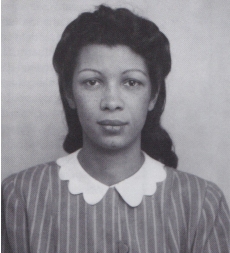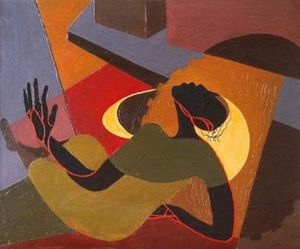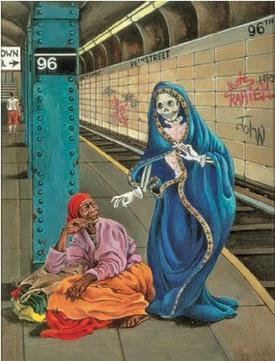Rose Piper facts for kids
Quick facts for kids
Rose Piper
|
|
|---|---|

Rose Piper, c. 1943
|
|
| Born |
Rose Theodora Sams
October 7, 1917 New York City, New York, U.S.
|
| Died | May 11, 2005 (aged 87) Connecticut, U.S.
|
| Education | Hunter College |
| Known for | Painting, Textile design |
Rose Theodora Piper (born October 7, 1917 – died May 11, 2005) was an American painter. She was famous for her paintings from the 1940s that were inspired by blues music. These paintings often used a "semi-abstract" style, meaning they showed real things but in a simplified or changed way.
Later, in the 1950s, Rose Piper needed to earn more money. So, she started working as a textile designer. This meant she created patterns for fabrics. For almost 30 years, she was known as Rose Ransier and designed knit fabrics.
People really noticed her art in 1947. She had her first art show in New York City. It was called Blues and Negro Folk Songs. The show displayed 14 paintings based on folk and blues songs. It was a big success! Art critics loved it, and almost all the paintings were sold. Rose Piper was one of only four African-American abstract painters to have a solo show in New York at that time. After she stopped designing textiles, she started painting and showing her art again in the 1980s.
Contents
Early Life and Learning to Paint
Rose Theodora Sams was born in New York City on October 7, 1917. She grew up in the Bronx. Her father was a schoolteacher who taught Latin and Greek.
Rose went to Evander Childs High School. She studied art there and earned a special scholarship to Pratt Institute. But she couldn't go because of family reasons. Instead, she went to Hunter College. She studied art and also geometry, graduating in 1940.
From 1943 to 1946, she studied at the Art Students League of New York. During this time, a poet named Myron O'Higgins introduced her to Sterling Allen Brown. He helped her become more interested in blues music.
Rose Piper's Art Career
Blues-Inspired Paintings
In 1946, Rose Piper received a special grant called a Julius Rosenwald fellowship. She used it to travel in the American South during the summer. She wanted to experience the atmosphere and learn more about blues music. She said she "worked at it," listening to many recordings.
Her research led her to create a series of blues-themed paintings. These paintings became more and more abstract. Her early painting, Back Water (1946), was inspired by Bessie Smith's "Backwater Blues." It showed things more clearly. But by 1947, Piper started using a flatter, more geometric style. You can see this in paintings like Slow Down, Freight Train and The Death of Bessie Smith (shown here).
Art expert Graham Lock said this semi-abstract style was perfect for blues music. Blues songs often use exaggeration to show strong feelings. Rose Piper always kept human figures in her art. She never painted completely abstract works. Her goal was to use her art to fight unfairness. She wanted to "put it on the canvas."
Her art became famous in 1947 with her first solo show at the Roko Gallery in New York. The show, called Blues and Negro Folk Songs, had 14 paintings. Critics loved the show, and it stayed open an extra week. Most of the paintings were sold. At that time, she was one of only four African-American abstract painters to have a solo show in New York. The others were Romare Bearden, Norman Lewis, and Thelma Johnson Streat.
In 1948, she had another success. Her painting Grievin' Hearted won an award at a big art exhibition. This show was held by Atlanta University and was very important for black artists.
Rose Piper's career was at its highest point in the late 1940s. She had a studio in Greenwich Village and showed her art in important galleries. Her work was reviewed in major art magazines. She knew famous people like James Baldwin, Billie Holiday, and Langston Hughes. Charles Alston was also a friend and helped her with her art. She later said, "The world was at my feet."
One of her paintings, Slow Down, Freight Train, showed a woman left behind by men who rode freight trains north. This painting was a very different style from her earlier work.
Even though her blues paintings were popular, Piper didn't want to be known only as a "black painter" who painted "black" themes. So, when she got another grant in 1948, she chose to work in Paris. She wanted to explore new ideas instead of continuing to focus on the American South.
Designing Textiles
When Rose Piper came back from Paris, she faced some money and family problems. She had to stop painting for a while. She even ran her own greeting card business for a time. Then, she started working as a textile designer. She used the name Rose Ransier for this job.
For the next 30 years, she had a successful career in fashion. She designed fabrics, especially for knitwear. Her geometry skills helped her a lot. She could design patterns on graph paper that worked perfectly for knitting machines. In 1973, she won a big award from the Knitted Textile Association. When she retired in 1979, she was a senior vice president.
Later Artworks
In the 1980s, Rose Piper started painting again. Her new style was different. It was influenced by her years in textile design. Instead of semi-abstract art and dark colors, her later paintings had bright colors and lots of detail. She was inspired by old European painters like Hans Memling and Jan van Eyck. She also liked medieval Book of Hours, which were prayer books with beautiful pictures.
She still found ideas in African-American music. Her goal to fight injustice through art had not changed. In 1989, she had another solo art show in New York. The main part of the show was called Slave Song Series. It was a group of ten small paintings based on lines from spiritual songs. Some of these paintings showed modern city places. For example, Go Down Neath, Easy An’ Bring My Servant Home (shown here) is set in a subway station. She wrote that the problems faced by many black people in cities were similar to the struggles of their slave ancestors.
Death
Rose Piper passed away from a stroke on May 11, 2005. She was 87 years old and died in a nursing home in Connecticut.
Personal Life
Rose Piper had two children, a son and a daughter. She was also the aunt of the famous artist Adrian Piper.
Selected Exhibitions
- Blues and Negro Folk Songs, RoKo Gallery, New York, 1947
- 7th Annual Exhibition of Paintings, Sculpture and Prints by Negro Artists, Atlanta University, 1948
- Rose Piper: Paintings and Works on Paper, Phelps-Stokes Fund, New York, 1989
- The Search for Freedom: African-American Abstraction 1945–1975, Kenkeleba Gallery, New York, 1991
- A Force for Change: African American Art and the Julius Rosenwald Fund, Spertus Museum, Chicago, 2009
See also
- New York Figurative Expressionism



